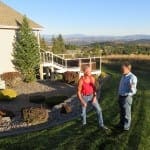Moving from Suggestions to Mandates to Cut Wildfire Risk For Rural Homes
 Photo by Tom Banse
Photo by Tom Banse
September 20, 2016 - 4:41 pm
Some Northwest cities, counties and private developers are going beyond the minimums in the state building codes to reduce wildfire risk. They’re banning shingle roofs and requiring fire-resistant siding. They’re also making homeowners mind their landscaping. Correspondent Tom Banse has more from near Spokane.
Left: Developer Chris Heftel (right) and homeowner Mike Thompson discuss wildfire safety measures in the River Bluff Ranch community north of Spokane.
Developer Chris Heftel made an interesting choice when he converted a forested hillside and grazing land into a gated community called River Bluff Ranch. There are websites and brochures full of advice for how to build in wildfire country like this. In this development though, the tips are not merely advice, they’re the rule – enforced by covenants on the properties.
Chris Heftel: “If it was voluntary, you’d have some compliant, some non-compliant. The non-compliant homes put everybody else at risk.”
Heftel takes me to a lane of custom homes and points out common features such as the asphalt composition roofs.
Chris Heftel: “Almost impossible to set those on fire from an ember or something coming down and landing on them as opposed to say, a shake roof.”
Home siding also has to be nonflammable or fire resistant, typically accomplished here with fiber-cement board, such as HardiePlank accented with stone veneer.
Landscaping is the other critical piece.
Chris Heftel: “It’s not just the construction materials, but it’s also maintaining the defensible space around your home.”
Individual homeowners must keep their yards “lean and green” – as they call it. Many installed a rockery ring around their foundations. These measures combined can’t guarantee a fire-proof neighborhood, but Heftel says they would affect a wildfire’s behavior around the homes.
Chris Heftel: “It’s going to burn much less hot and probably travel more slowly, easier for fire responders to get it under control.”
Two other Northwest developments taking this approach to be safer from the start include the big Suncadia Resort near Roslyn, Washington, and The Tree Farm subdivision outside Bend, Oregon. Suncadia’s construction guidelines additionally require indoor sprinklers in new residential homes.
At River Bluff Ranch, resident Mike Thompson says “Firewise” features were on his mind when he and his wife were house hunting.
Mike Thompson: “Knowing that the developer Chris had gone through and done limbing (i.e., trimmed dead tree limbs up from the ground) and cleaned out the underbrush and done some of those things to make it more protected was definitely something for us that was a good selling point.”
Thompson says he doesn’t think he paid “all that much more” for his fire-resistant, ridgetop ranch home. The retired fire chief now heads the development’s homeowner association, which provides ongoing enforcement of those covenants.
So there’s a case where a developer and homeowners are imposing rules on themselves. A slowly growing number of Northwest cities and counties are applying similar rules to everyone who builds in wildfire prone zones.
Alan Crankovich: “You know, I’m an advocate for property rights…”
Former Kittitas County Commissioner Alan Crankovich got the ball rolling for his central Washington county to adopt what is known as the Wildland Urban Interface Code.
Alan Crankovich: “You are asking to build a home in an area where there has traditionally not been (one). So now, to me to allow you to do that there comes a personal responsibility to provide some protection for yourself as well as the surrounding landowners.”
California years ago led the way on this. Yakima and Douglas counties in central Washington and Jackson County in southern Oregon have also added wildfire protection rules to their building codes. The cities of Wenatchee and Boise have too, motivated by experience with destructive fires. Cowlitz County, Washington, looks to be next in line to act. Bend, Oregon and surrounding Deschutes County are also taking a hard look at this. But that leaves far more Pacific Northwest counties not on board. Earlier this year a firefighters association asked the Washington Legislature to make a model wildfire code apply statewide. But realtors, homebuilders and counties snuffed out that proposal with the argument that a “one size fits all” solution is inappropriate.



